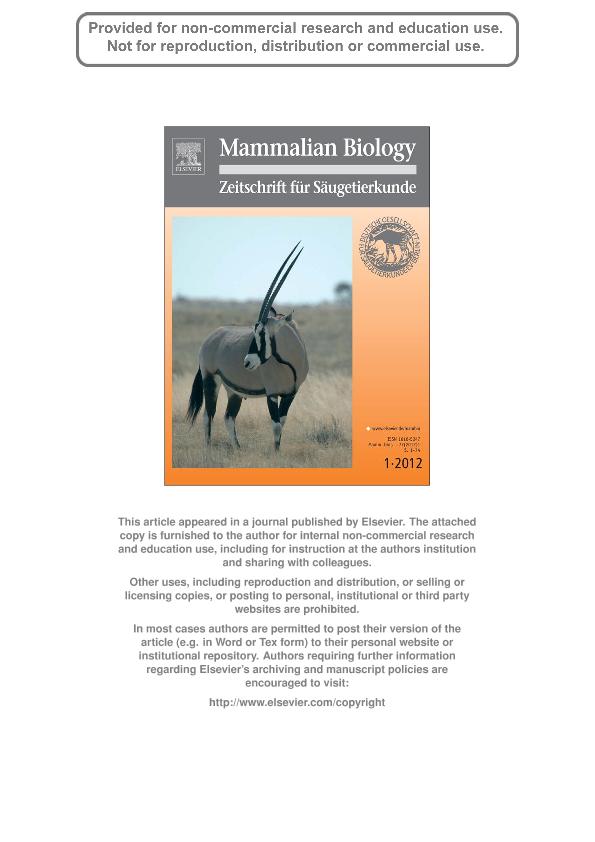Mostrar el registro sencillo del ítem
dc.contributor.author
Sanchez, Mariano Sebastian

dc.contributor.author
Giannini, Norberto Pedro

dc.contributor.author
Barquez, Ruben Marcos

dc.date.available
2018-10-17T16:48:02Z
dc.date.issued
2012-01
dc.identifier.citation
Sanchez, Mariano Sebastian; Giannini, Norberto Pedro; Barquez, Ruben Marcos; Bat frugivory in two subtropical rain forests of Northern Argentina: Testing hypotheses of fruit selection in the Neotropics; Elsevier Gmbh; Mammalian Biology; 77; 1; 1-2012; 22-31
dc.identifier.issn
1616-5047
dc.identifier.uri
http://hdl.handle.net/11336/62566
dc.description.abstract
Phyllostomid bats are prominent components of mammalian assemblages in the Neotropics. With many species specialized in frugivory, phyllostomids represent major partners of fleshy-fruited plants in the mutualism of seed dispersal. Here we present dietary data from two subtropical rainforests of Argentina, where fruit diversity is low and thus offer unique opportunities to test hypotheses of diet selection originally proposed for species-rich tropical assemblages. Particularly, we tested whether frugivorous phyllostomids exhibit pronounced dietary specialization in core plant taxa where fruit offer is greatly reduced as compared to tropical rainforests. We analyzed dietary overlap and niche breadth of subtropical frugivorous bats on the basis of >1000 dietary records plus >500 samples from a previous study in the region. We show that in the subtropics, frugivores from different genera remain faithful to their respective core plant taxa with few exceptions, rather than shifting toward alternative fruit resources available in the study sites. This supports predictions of specialization, which is confirmed to have a deep historical origin. The response of phyllostomid ensembles to restricted fruit diversity is at the level of species composition: absence of species for which preferred fruits do not occur in the sites. Taken together, these data lend strong support to hypotheses that explain coexistence of frugivorous phyllostomids on the basis of dietary specialization on core plant taxa with chiropterochorous fruits. © 2011 Deutsche Gesellschaft für Säugetierkunde.
dc.format
application/pdf
dc.language.iso
eng
dc.publisher
Elsevier Gmbh

dc.rights
info:eu-repo/semantics/openAccess
dc.rights.uri
https://creativecommons.org/licenses/by-nc-sa/2.5/ar/
dc.subject
Artibeus
dc.subject
Carollia
dc.subject
Diet Selection
dc.subject
Fruit Morphology
dc.subject
Sturnira
dc.subject.classification
Otras Ciencias Biológicas

dc.subject.classification
Ciencias Biológicas

dc.subject.classification
CIENCIAS NATURALES Y EXACTAS

dc.title
Bat frugivory in two subtropical rain forests of Northern Argentina: Testing hypotheses of fruit selection in the Neotropics
dc.type
info:eu-repo/semantics/article
dc.type
info:ar-repo/semantics/artículo
dc.type
info:eu-repo/semantics/publishedVersion
dc.date.updated
2018-10-12T18:37:34Z
dc.journal.volume
77
dc.journal.number
1
dc.journal.pagination
22-31
dc.journal.pais
Alemania

dc.journal.ciudad
Jena
dc.description.fil
Fil: Sanchez, Mariano Sebastian. Consejo Nacional de Investigaciones Científicas y Técnicas; Argentina. Universidad Nacional de Tucumán. Facultad de Ciencias Naturales e Instituto Miguel Lillo; Argentina
dc.description.fil
Fil: Giannini, Norberto Pedro. Consejo Nacional de Investigaciones Científicas y Técnicas; Argentina. Universidad Nacional de Tucumán. Facultad de Ciencias Naturales e Instituto Miguel Lillo; Argentina. American Museum of Natural History; Estados Unidos
dc.description.fil
Fil: Barquez, Ruben Marcos. Consejo Nacional de Investigaciones Científicas y Técnicas; Argentina. Universidad Nacional de Tucumán. Facultad de Ciencias Naturales e Instituto Miguel Lillo; Argentina
dc.journal.title
Mammalian Biology

dc.relation.alternativeid
info:eu-repo/semantics/altIdentifier/url/https://www.sciencedirect.com/science/article/pii/S161650471100070X
dc.relation.alternativeid
info:eu-repo/semantics/altIdentifier/doi/https://dx.doi.org/10.1016/j.mambio.2011.06.002
Archivos asociados
